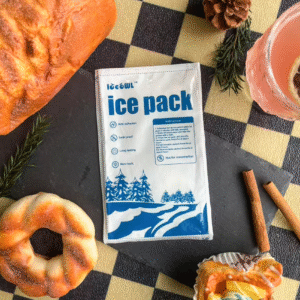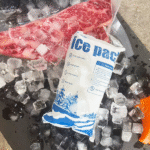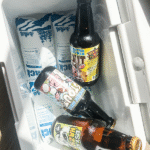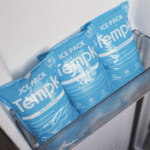Der Versand verderblicher Waren im ganzen Land erfordert Präzision und sorgfältige Planung, um sicherzustellen, dass die Produkte innerhalb des erforderlichen Temperaturbereichs bleiben. Trockeneisbeutel sind eine der effektivsten Lösungen, um während des Transports kühle Temperaturen aufrechtzuerhalten. Dieser Leitfaden befasst sich mit Best Practices, regulatorische Überlegungen, Verpackungstechniken, und die Vorteile der Verwendung von Trockeneis für den Überlandtransport in 2025.
Was sind Trockeneisbeutel und warum sind sie ideal für den grenzüberschreitenden Versand??
Trockeneis ist festes Kohlendioxid (Co₂) das direkt vom Feststoff in den Gaszustand sublimiert, Dadurch entsteht eine extrem niedrige Temperatur von -78,5 °C (-109.3° F). Diese Eigenschaft macht Trockeneisbeutel ideal für die Aufrechterhaltung des Gefrierzustands während des Ferntransports. Wird häufig für Arzneimittel verwendet, Essen, und Biotechnologie, Trockeneis sorgt dafür, dass temperaturempfindliche Waren eine optimale Temperatur haben, ohne dass die Gefahr von Schäden durch flüssiges Wasser besteht.
-
Pharmazeutika: Unverzichtbar für den Transport von Impfstoffen, Biologika, und temperaturempfindliche Medikamente.
-
Essen: Stellt sicher, dass gefrorene Lebensmittel wie Meeresfrüchte und Fleisch in ausgezeichnetem Zustand ankommen, Verderb verhindern.
-
Biotechnologie: Entscheidend für biologische Proben und experimentelle Materialien, die eine präzise Temperaturkontrolle erfordern.
Wie funktioniert Überlandversand mit Trockeneis-Packs Arbeiten?
Der Versand mit Trockeneis umfasst mehrere Schritte, um sicherzustellen, dass die Waren während des gesamten Transports gefroren bleiben. So funktioniert es:
1. Verpacken der Sendung
-
Die Produkte werden in isolierten Verpackungen mit Trockeneisbeuteln aufbewahrt. Die Isolierung verhindert, dass äußere Hitze auf die Ware einwirkt, während das Trockeneis dazu beiträgt, die Temperaturen unter Null zu halten.
2. Auswahl des richtigen Trockeneisbeuteltyps
-
Basierend auf der Größe der Sendung und der Transportdauer, die richtige Menge Trockeneis wird berechnet. Zu wenig Trockeneis kann zum Auftauen führen, während zu viel ineffizient und verschwenderisch ist.
3. Den richtigen Versandservice auswählen
-
Wählen Sie einen spezialisierten Kurierdienst mit Erfahrung im Umgang mit temperaturempfindlichen Sendungen. Der Spediteur sollte eine Echtzeitüberwachung der Temperaturbedingungen bieten, um sicherzustellen, dass die Waren innerhalb des erforderlichen Temperaturbereichs bleiben.
4. Echtzeitüberwachung und Temperaturregelung
-
Viele Reedereien bieten Temperaturüberwachungstools an, die Echtzeitdaten liefern, So stellen Sie sicher, dass sofort Korrekturmaßnahmen ergriffen werden können, wenn die Temperaturen vom gewünschten Bereich abweichen.
Hauptvorteile der Verwendung von Trockeneisbeuteln für den grenzüberschreitenden Versand
Trockeneisbeutel sind aufgrund ihrer Effizienz und Zuverlässigkeit eine bevorzugte Lösung für den grenzüberschreitenden Versand:
1. Verlängerte Haltbarkeit
-
Trockeneis kann Produkte über einen längeren Zeitraum gefroren halten, Dies ist bei Sendungen, die mehrere Tage dauern, unerlässlich.
2. Konsistente und zuverlässige Kühlung
-
Im Gegensatz zu normalem Eis, das schmilzt und Feuchtigkeit erzeugt, Trockeneis untermauert direkt in Gas, Vermeidung von Wasserschadenrisiken.
3. Kostengünstige Lösung
-
Trockeneis erfordert keine zusätzliche Kühlausrüstung oder Strom, Dies macht es zu einer erschwinglichen Wahl für den Versand von Waren über große Entfernungen.
4. Umweltfreundlich
-
Trockeneis sublimiert ohne Rückstände zu hinterlassen, im Gegensatz zu chemischen Kältemitteln. Es ist eine nachhaltigere Option, da es eine natürlich vorkommende Substanz verwendet – Kohlendioxid.
Best Practices für einen sicheren und effizienten grenzüberschreitenden Versand mit Trockeneis
Um die Sicherheit und Effizienz Ihrer Sendung zu gewährleisten, müssen Sie diese Best Practices befolgen:
1. Verwenden Sie die richtige Verpackung
-
Isolierte Kühlboxen und Behälter sind unerlässlich, um die Temperaturen niedrig zu halten und Waren vor Beschädigungen zu schützen. Eine speziell für Trockeneis konzipierte Verpackung sorgt dafür, dass es effizient funktioniert.
2. Berechnen Sie die richtige Menge Trockeneis
-
Es ist wichtig zu berechnen, wie viel Trockeneis benötigt wird, um die Temperatur während der gesamten Fahrt aufrechtzuerhalten. Dies hängt von Faktoren wie der Sendungsgröße ab, Transitzeit, und externe Temperaturen.
3. Wählen Sie einen zuverlässigen Spediteur
-
Arbeiten Sie mit Kurieren zusammen, die auf den Versand temperaturempfindlicher Waren spezialisiert sind. Sie sollten Erfahrung im Umgang mit Trockeneis haben und Tracking- und Überwachungsmöglichkeiten bieten.
4. Verstehen Sie regulatorische Anforderungen
-
Verschiedene Spediteure und Gerichtsbarkeiten haben spezifische Regeln für den Versand von Trockeneis. Stellen Sie die Einhaltung dieser Vorschriften sicher, um Verzögerungen oder Bußgelder zu vermeiden. Zum Beispiel, Die Internationale Luftverkehrsvereinigung (Iata) und die USA. Verkehrsministerium (PUNKT) haben Richtlinien für den Trockeneisversand.
Häufige Anwendungen von Trockeneis in der Überlandschifffahrt
Mehrere Branchen verlassen sich bei der Überlandschifffahrt auf Trockeneis. Hier sind einige häufige Anwendungen:
1. Pharmazeutische Versand
-
Die Gewährleistung der Sicherheit und Wirksamkeit von Impfstoffen und Biologika beim Ferntransport ist von entscheidender Bedeutung. Trockeneis hilft, die erforderlichen Temperaturen aufrechtzuerhalten, Sicherstellen, dass sensible Produkte haltbar bleiben.
2. Lebensmittelversand
-
Für den Versand von gefrorenen Lebensmitteln wie Fleisch und Meeresfrüchten ist Trockeneis erforderlich, um ein Verderben zu verhindern und die Frische während des Transports zu bewahren.
3. Biotechnologie-Versand
-
Biotech-Unternehmen nutzen Trockeneis zum Transport biologischer Proben, Forschungsmaterialien, und Kulturen, um sicherzustellen, dass die Integrität ihrer Produkte gewahrt bleibt.
4. E-Commerce
-
Online-Händler von Tiefkühlwaren können Trockeneis für den Versand von Produkten wie Tiefkühlgerichten und Eis verwenden, um sicherzustellen, dass sie in einwandfreiem Zustand beim Kunden ankommen.
2025 Trends bei Trockeneisschifffahrt
Die Kühlkettenlogistik entwickelt sich weiter, und der Trockeneisversand ist da keine Ausnahme. Hier sind einige wichtige Trends, die diese Branche prägen:
1. Echtzeit-Temperaturüberwachung
-
Fortschritte in der Temperaturüberwachungstechnologie verbessern die Zuverlässigkeit, Damit können Unternehmen Sendungen verfolgen und Benachrichtigungen erhalten, wenn die Temperaturen außerhalb des zulässigen Bereichs liegen.
2. Nachhaltige Praktiken
-
Unternehmen konzentrieren sich zunehmend auf umweltfreundliche Alternativen zu herkömmlichen Verpackungsmaterialien, wie recycelbare Isolierung und biologisch abbaubare Kühler.
3. IoT-fähige Versandlösungen
-
Die Nutzung des Internets der Dinge (IoT) Geräte zur Sendungsüberwachung sind weit verbreitet. Diese Sensoren liefern Echtzeitdaten, Dies trägt dazu bei, dass die Produkte immer im richtigen Temperaturbereich gehalten werden.
Häufige Fragen zum Versand mit Trockeneis
Wie lange ist Trockeneis in der Überlandschifffahrt haltbar??
Trockeneis kann dazwischen dauern 18 Zu 36 Stunden abhängig von der Isolationsqualität und den Umgebungsbedingungen. Für Sendungen, die länger dauern, Es ist mehr Trockeneis erforderlich.
Kann ich Flüssigkeiten mit Trockeneisbeuteln versenden??
Ja, Flüssigkeiten können mit Trockeneis versendet werden, vorausgesetzt, sie sind ordnungsgemäß abgedichtet, um Undichtigkeiten zu vermeiden. Trockeneis hält die Flüssigkeiten während des gesamten Versandprozesses auf der erforderlichen Temperatur.
Abschluss
Der Versand mit Trockeneisbeuteln ist eine effiziente und zuverlässige Methode für den Transport temperaturempfindlicher Güter über große Entfernungen. Indem Sie die in diesem Leitfaden beschriebenen Best Practices befolgen, inklusive der Auswahl der richtigen Verpackung, Berechnung des Trockeneisbedarfs, und das Verständnis regulatorischer Vorschriften, Unternehmen können die sichere Lieferung ihrer Produkte gewährleisten und gleichzeitig die Vorschriften einhalten.
Aufruf zum Handeln
Auf der Suche nach einer zuverlässigen Trockeneis-Versandlösung? Kontaktieren Sie uns noch heute, um zu erfahren, wie wir Ihnen helfen können, Ihre Kühlkettenlogistik zu optimieren und den sicheren Transport Ihrer temperaturempfindlichen Waren zu gewährleisten.
Über Tempk
Und Tempk, Wir sind auf die Bereitstellung von Kühlkettenlogistikdienstleistungen spezialisiert, Wir bieten sichere Trockeneis-Packlösungen an, zuverlässiger grenzüberschreitender Versand. Unsere fortschrittlichen Systeme sorgen dafür, dass Ihre Waren während der gesamten Reise die richtige Temperatur haben, So können Sie beruhigt sein und die Kundenzufriedenheit verbessern.
Bereit zum Versand mit Zuversicht? Kontaktieren Sie unser Team für persönliche Beratung und Unterstützung bei Ihrer nächsten Trockeneislieferung.
























